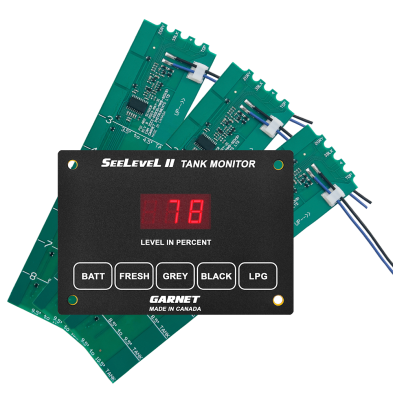A stabilizer jack for a camper is a simple but essential piece of gear that extends from your RV’s frame to the ground. Its one job? To eliminate that annoying wobble and sway you feel whenever you’re parked. Think of it as the fix that stops your rig from feeling like a boat every time someone walks from one end to the other.
Quick links: Shop all stabilizer jacks · Manual scissor jacks · Electric stabilizer systems · Stabilizer accessories · Jack pads · Leveling blocks
Why Your Camper Wobbles and How to Stop It

If you’ve ever been jolted awake because someone got up for a midnight snack, you know the feeling. That constant motion can make simple tasks feel shaky and really takes away from the comfort of your home-on-wheels. It’s a classic issue for almost every towable RV out there, from tiny travel trailers to massive fifth wheels.
The culprit is your camper’s suspension system. Those tires and springs are fantastic for smoothing out bumps on the highway, but once you’re parked, that same flexibility creates a ton of unwanted movement. A stabilizer jack is the tool that bridges the gap between your camper’s frame and the solid ground, bracing it firmly in place.
The Critical Difference Between Stabilizing and Leveling
Key Takeaway: You must always level your RV before you stabilize it. Leveling makes your camper flat; stabilizing makes it steady. One cannot do the other’s job. Use leveling blocks or leveling jacks first, then deploy stabilizers.
How Stabilizers Create a Rock-Solid Feel
Once your camper is perfectly level, deploy the stabilizers so they’re snug—not lifting. Add jack pads under each foot for a wider footprint on soft ground.
Exploring Different Camper Stabilizer Jack Types
Manual Scissor Jacks: The Workhorse
Simple, strong, affordable. Crank by hand or use a drill with a stabilizer jack socket to speed things up. Browse scissor jacks.
Drop-Down Corner Jacks: The Standard Stabilizer
Permanently mounted, swing-down design—quick to deploy. See corner/steady jacks.
Electric and Hydraulic Systems: The Ultimate Convenience
Push-button deployment using 12V motors (or hydraulic power). Great for frequent campers. Shop electric stabilizer systems and hydraulic options.
Comparing Camper Stabilizer Jack Types
| Jack Type | Best For | Pros | Cons | Typical Price Range |
|---|---|---|---|---|
| Manual Scissor | All-around use, heavy rigs, and budget builds. | High stability, durable, affordable. | Manual effort; deploy each corner. | $50 – $150 per pair |
| Drop-Down Corner | Lighter trailers; fast setup. | Always attached; quick swing-down. | Less fine height control. | $40 – $100 per pair |
| Electric/Hydraulic | Full-timers; max convenience. | Push-button, fast. | Higher cost; 12V/hydraulic complexity. | $500 – $2,500+ per system |
How to Choose the Right Stabilizer Jack
Determine the Correct Weight Capacity
Aim for combined stabilizing capacity ≈ 50–75% of GVWR. Then pick from our stabilizer selection.
Measure for the Perfect Fit
Confirm extended/retracted heights and mounting footprint. Add pads or interlocking blocks for tricky sites.
Assess Build Quality and Materials
Prefer heavy-gauge steel and powder/e-coat. See premium stabilizers and mounting hardware.
Installing and Using Your Stabilizer Jacks

Level first with blocks, then stabilize. Use a drill socket to speed scissor jacks. Always add pads on soft ground.
Pre-Installation Safety and Prep Work
Chock wheels (wheel chocks), work on firm/level ground, wear eye protection.
Mounting Your Stabilizer Jacks
Install near frame corners for the widest footprint. Use quality hardware. Consider professional welding if you want permanent mounts.
The Golden Rule of Operation: Level First, Then Stabilize
Snug contact only—do not lift. After contact, add ~½–1 turn to preload. Add pads to reduce extension and prevent sinking.
Maintenance and Troubleshooting for Your Jacks

Your Seasonal Maintenance Checklist
- Clean and inspect arms, welds, bolts.
- Lubricate screw/pivots with dry silicone spray.
- Replace worn feet or add pads.
Troubleshooting Common Jack Problems
Hard to crank / grinding: Clean threads, re-lube (dry silicone).
Still wobbly: Add pads, recheck frame bolts.
Electric jack dead: Check 12V supply, fuse/breaker, switch wiring.
Common Questions About Camper Stabilizer Jacks
Can I Use Stabilizer Jacks to Level My Camper?
No. Level with blocks or leveling jacks first, then stabilize.
How Tight Should My Stabilizer Jacks Be?
Snug contact + ~½–1 turn. Don’t lift the rig.
What Is the Difference Between a Stabilizer and a Leveler?
Levelers lift and hold; stabilizers brace and stop motion. Different tools, different jobs.
Should I Use Blocks Under My Stabilizer Jacks?
Yes—use jack pads or blocks to reduce extension, prevent sinking, and protect the feet.
Ready to stop the wobble? Start with stabilizer jacks, add pads and a drill socket for fast setup, and keep dry silicone on hand for smooth operation.











